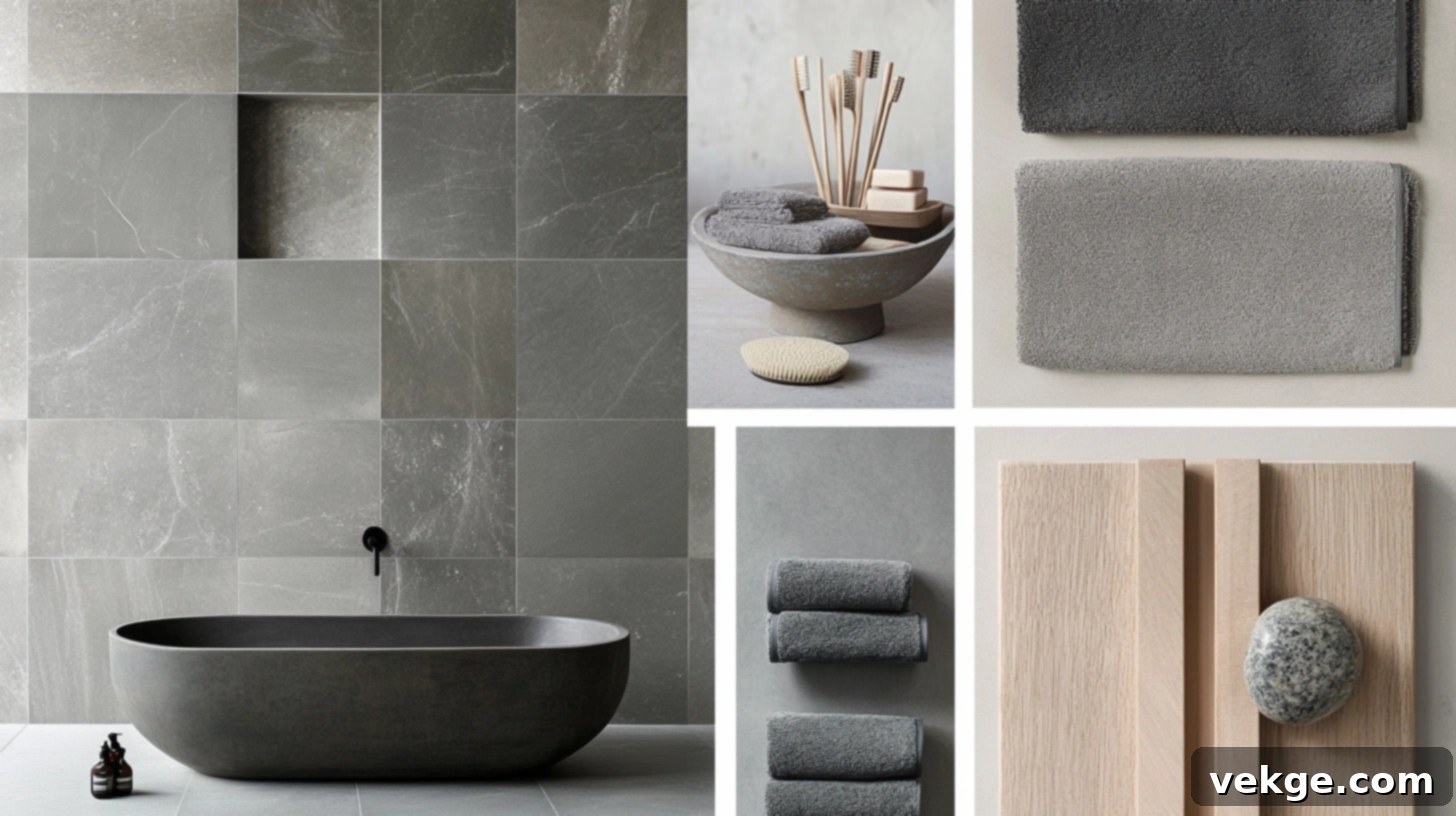Design Your Perfect Sanctuary: A Comprehensive Guide to Bathroom Mood Boards
Have you ever stepped into your bathroom and felt a subtle sense of dissatisfaction, or perhaps a strong urge for a refresh? Many of us have. That feeling of an uninspired space can often set the tone for the start of your day. But what if transforming your bathroom into a personal oasis was simpler than you imagined?
The secret to a successful bathroom transformation often lies in a powerful, yet often overlooked, tool: the mood board. This simple and effective method allows you to visualize and plan your dream bathroom before you spend a single penny. It’s a crucial step that can prevent costly mistakes and ensure your final design perfectly matches your vision.
By investing time in creating a comprehensive bathroom mood board, you can identify potential design clashes, refine your aesthetic, and confidently make choices that reflect your unique style. It serves as your personal design blueprint, guiding every decision from tile selection to fixture finishes.
This guide will walk you through my proven, step-by-step method for creating a bathroom mood board that truly works. From understanding your personal style to budgeting and avoiding common pitfalls, you’ll gain the knowledge and confidence to bring your bathroom ideas to life.
By the end of this article, you’ll be equipped to turn abstract bathroom concepts into a concrete, actionable plan, ensuring your renovation journey is smooth, efficient, and ultimately, rewarding. Let’s create a bathroom you’ll love waking up to!
What Exactly is a Bathroom Mood Board and Why Is It So Crucial?
At its core, a bathroom mood board is a dynamic visual planning tool. It’s a curated collection of physical samples, digital images, and textural elements that represent your desired bathroom aesthetic. Think of it as a tangible preview of your future bathroom’s ambiance, allowing you to see how every element harmonizes before committing to purchases.
A well-crafted mood board brings together all the sensory components of your design vision. Here are the essential elements typically included in an effective bathroom mood board:
- Paint Swatches: Small samples of potential wall colors to assess how light affects them.
- Tile Samples: Physical pieces of floor and wall tiles to evaluate texture, color, and finish.
- Fixture Finishes: Examples of faucet materials, cabinet handles, towel rails, and lighting finishes (e.g., brushed nickel, matte black, polished chrome).
- Cabinet Materials and Colors: Samples of wood, laminate, or paint finishes for your vanity and storage units.
- Fabric Swatches: If applicable, samples for window treatments, shower curtains, or decorative towels.
- Key Item Photos: Images of larger items like a vanity, mirror, bathtub, or specific lighting fixtures.
- Inspirational Images: Pictures of completed bathrooms or specific design details that resonate with your style.
You might wonder why such a detailed process is necessary. Here are three compelling reasons why a bathroom mood board is an invaluable asset:
- Visual Cohesion: It helps you literally see how all the different elements – colors, textures, materials, and styles – come together in one unified space before any actual renovation begins.
- Early Problem Detection: You can quickly spot clashing colors, competing patterns, or mismatched styles. This allows for adjustments and corrections on paper, saving you significant time and money down the line.
- Streamlined Shopping and Communication: With a clear visual guide, shopping becomes incredibly efficient. You know exactly what you’re looking for. Furthermore, when communicating your vision to contractors, designers, or suppliers, your mood board serves as a clear, unmistakable reference, ensuring everyone is aligned with your goals.
Experience has taught me that dedicating time to mood board creation is the ultimate safeguard against costly design mistakes. It transforms abstract ideas into a concrete plan, making the entire renovation process smoother and more enjoyable.
The Undeniable Importance of Understanding Your Personal Style
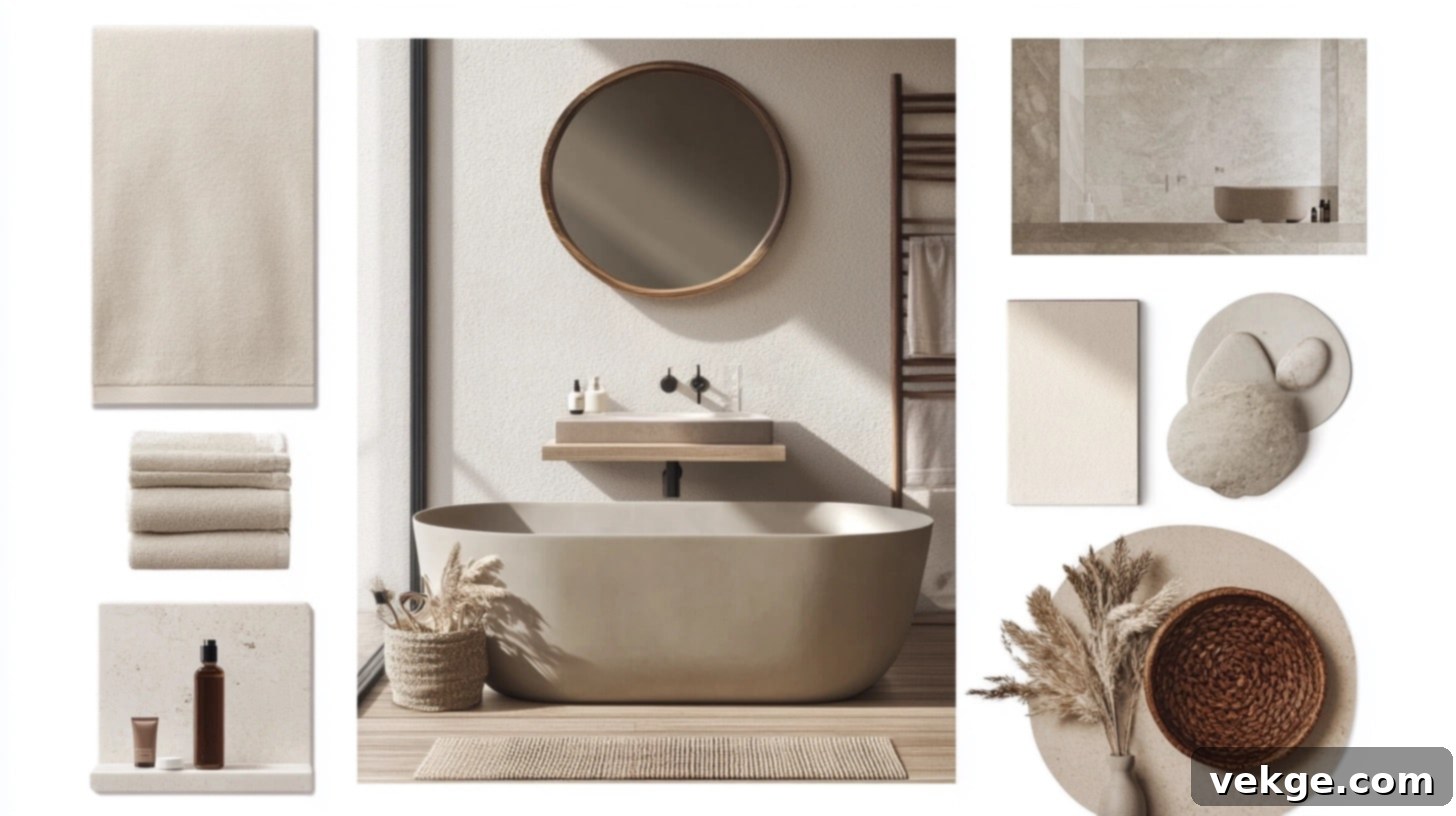
Before diving into a sea of tile samples and paint chips, understanding your personal style is paramount. It acts as your design compass, guiding every decision and ensuring your bathroom feels authentically ‘you.’ A beautiful bathroom featured in a magazine might not evoke the same sense of comfort and joy for you. This is why self-discovery in design is so critical.
To begin uncovering your unique aesthetic:
- Observe Your Wardrobe: Do you gravitate towards clean lines, vibrant colors, or soft, muted tones? Your clothing choices often reflect your innate design preferences.
- Analyze Your Current Living Spaces: What elements do you love in your living room or bedroom? Is it minimalist, bohemian, traditional, or something else?
- Identify Recurring Preferences: Notice patterns in items you purchase for your home, from kitchenware to decorative accents.
- Document Inspirations: Make mental or physical notes of bathrooms you admire in real life, in media, or at friends’ houses. What exactly catches your eye?
To truly refine your understanding of your style, consider these actionable steps:
- Curate a Digital Collection: Save photos of bathrooms, specific fixtures, or even small details that resonate with you. Pinterest and Houzz are excellent platforms for this.
- Pinpoint Attraction Points: For each saved image, ask yourself: “What specifically draws my attention first?” Is it the color scheme, the tile pattern, the vanity style, or the overall mood?
- Look for Common Threads: As your collection grows, analyze it for repeating elements. Are there certain colors, textures, or design eras that keep reappearing?
- Connect with Emotions: Pay attention to the colors and styles that evoke feelings of calm, energy, luxury, or comfort. Your bathroom should be a sanctuary tailored to your emotional needs.
Your personal style often manifests in subtle yet significant details:
- The specific metal finish you prefer for handles and faucets – perhaps warm brass over cool chrome.
- The type of lighting that makes you feel relaxed or energized – soft ambient glow versus bright task lighting.
- The tile patterns that capture your imagination – intricate mosaics, classic subway tiles, or large format modern slabs.
- The color palettes that intrinsically help you unwind and feel at home.
A strong grasp of your personal style empowers you to:
- Make Confident Design Choices: You’ll trust your instincts rather than second-guessing every decision.
- Stay Within Budget: Knowing your style helps you prioritize what matters most, preventing impulse buys that don’t fit the overall vision.
- Select Enduring Materials: You’ll choose elements that you’ll love for years, avoiding fleeting trends.
- Craft a Truly Enjoyable Space: Ultimately, your bathroom will be a reflection of you, a space you genuinely cherish and enjoy using daily.
Remember: There is no ‘right’ or ‘wrong’ style. The goal is to discover what resonates with you, creating a bathroom that feels like an authentic extension of your home and personality.
Gathering Inspiration and Materials For Your Bathroom Mood Board
With a clearer understanding of your personal style, the next exciting phase is to gather inspiration and physical materials. This stage is about exploration and collection, laying the groundwork for your mood board.
1. Sources for Inspiration
Inspiration is everywhere. The key is to know where to look and how to collect effectively.
Online Platforms: Pinterest, Houzz, Instagram
Digital platforms are treasure troves of bathroom design ideas. I highly recommend starting your search here:
- Pinterest: Create dedicated boards for different bathroom styles (e.g., “Modern Coastal Bathroom,” “Minimalist Spa Bath”). Pin everything that catches your eye, then revisit later to curate and refine.
- Houzz: Excellent for visualizing layouts, specific product ideas, and seeing how design elements work in real homes. Its extensive photo database often includes product sourcing information.
- Instagram: Follow interior designers, home decor accounts, and use hashtags like #bathroomdesign, #bathroommakeover, #dreambathroom to discover current trends and unique design concepts. Save posts to your collections for easy reference.
As you browse, don’t just save images; analyze them. What specifically do you like about each picture? Is it the color palette, the tile choice, the vanity style, or the overall feeling?
Magazines and Showrooms
While digital is convenient, physical inspiration offers a different tactile experience:
- Home Design Magazines: Flip through pages, clip out layouts, fixtures, or color schemes you love. These provide a tangible connection to design ideas.
- Local Showrooms: Visiting tile stores, plumbing supply centers, and kitchen/bath showrooms is crucial. Here, you can touch and feel materials, see true colors under various lighting conditions, and understand scale. Take photos of displays that capture your attention, and don’t hesitate to ask for samples.
Showrooms offer the invaluable opportunity to interact with materials in three dimensions, something screens can’t fully replicate.
2. Collecting Images and Samples
Once you’ve identified sources, the next step is systematic collection.
How to Choose Relevant Visuals
Not every beautiful image is right for *your* bathroom. Be selective:
- Consider Your Space: Look for photos that align with the size and layout of your actual bathroom. A design that looks stunning in a spacious master bath might not translate well to a compact powder room.
- Focus on Specific Details: Beyond overall aesthetics, save images that highlight particular features you want, such as a specific shower niche design, a unique sink style, or a clever storage solution.
- Prioritize Authenticity: Choose visuals that genuinely inspire you and align with your personal style, not just what’s trendy. This focused approach ensures your mood board remains practical, useful, and truly reflective of your desires.
Considering Colors, Textures, and Materials
This is where your mood board truly comes to life. Collect physical samples whenever possible:
- Paint Chips: Grab multiple shades that you’re considering, especially from different brands.
- Tile Samples: Acquire samples for both floor and wall tiles. Place them next to each other to see how they interact.
- Fabric Swatches: If fabric is part of your design, get samples to assess drape, color, and texture.
- Material Finishes: Request small samples or swatches of cabinet finishes, countertop materials, and metal finishes for fixtures.
Once collected, arrange these physical items together in various lighting conditions – natural daylight, evening light – to observe how colors shift and textures interplay. This hands-on process is critical for identifying harmonious combinations and spotting any elements that clash before you make expensive purchases.
Essential Tools and Resources for Creating Bathroom Mood Boards
Creating a bathroom mood board can be approached in several ways, depending on your preference for digital convenience or tangible, hands-on creation. Both methods offer unique benefits, and sometimes, a hybrid approach works best.
| Category | Description | Examples/Tools | Details |
|---|---|---|---|
| Digital Tools and Apps | Software and applications designed for creating virtual mood boards. These are excellent for compiling images, experimenting with layouts, and sharing your vision easily. | Canva, Milanote, Adobe Spark, Pinterest (for visual collection) | These tools often provide drag-and-drop interfaces, vast image libraries, and collaborative features. Many offer free versions with robust capabilities. Consider watching quick tutorials to get started efficiently. |
| Physical Mood Boards | Tactile boards made with physical elements, allowing you to touch, feel, and see actual samples. This method offers a strong sensory connection to your design. | Cork board, foam core board, large poster board, glue stick, scissors, printouts, fabric samples, paint chips, tile samples, hardware swatches | Steps for organizing materials include layering textures, arranging elements by function or aesthetic, and leaving space to add notes. Seeing physical samples side-by-side in real light is invaluable for material selection. |
| Templates and Downloads | Pre-designed, customizable templates that streamline the mood board creation process, offering a structured starting point. | Free downloadable templates on Canva, Pinterest (for template ideas), specific design blogs | These templates often come in various themes and aesthetics, providing a framework for your ideas. They can save time and ensure you include all necessary elements. Look for templates that allow you to easily swap images and text. |
Whether you lean towards digital platforms for their flexibility and sharing capabilities or prefer the tangible reality of physical samples, choose the tools that make the design process most intuitive for you. Many find success by using digital tools for initial inspiration and image collection, then transitioning to a physical board for final material pairing and color assessment.
Your Step-by-Step Guide to Creating an Impactful Bathroom Mood Board

With your inspiration gathered and your personal style identified, it’s time to construct your mood board. This systematic approach ensures every design decision is intentional and harmonized.
Step 1: Setting Your Goals and Budget
Before any creative design begins, clearly define your project’s scope and financial boundaries. Start by outlining your functional needs for the bathroom: Is it a master bath, a guest powder room, or a busy family bathroom? Who will be using it, and what are their daily routines?
- Functional Requirements: List your must-haves (e.g., double vanity, walk-in shower, ample storage, smart toilet).
- Budget Allocation: Establish a realistic budget from the outset. A common breakdown might be 35% for labor, 20% for fixtures, 15% for tiles, 10% for plumbing, 10% for lighting, and a crucial 10-15% for unexpected costs. Writing down these financial targets will help you stay focused and make informed decisions throughout the process.
- Timeline: Set a realistic timeline for your project, from planning to completion.
Understanding these foundational elements will significantly shape your design choices and prevent budget overruns or project delays.
Step 2: Choosing a Harmonious Color Palette
Color sets the entire mood of your bathroom. Approaching it strategically will ensure a cohesive and inviting space.
Color Theory Basics for Bathrooms
A simple yet effective method is the “60-30-10 rule” adapted for bathrooms:
- 60% Main Color: This is your dominant shade, typically used on large surfaces like walls or expansive tiles. Think of neutral tones for a serene feel or a soft hue for a subtle statement.
- 30% Secondary Color: This hue supports your main color and is used for larger items like vanities, accent tiles, or main fabric elements.
- 10% Accent Color: This is your ‘pop’ of color, reserved for smaller accessories, decorative items, or towels.
Remember that light colors generally open up smaller spaces, making them feel brighter and more expansive, while darker, richer tones can add depth, drama, and a sense of intimacy to larger bathrooms.
Tips for Small vs. Large Bathrooms
- Small Bathrooms: Opt for light, neutral colors on major surfaces (walls, large floor tiles) to maximize a sense of space. Consider reflective surfaces like gloss tiles or large mirrors to amplify light.
- Large Bathrooms: You have more freedom to introduce bolder colors or deeper tones as focal points, perhaps on an accent wall, a luxurious vanity, or a patterned floor.
Crucially, always test paint samples and tile colors directly in your bathroom at different times of day. Natural and artificial light can dramatically alter how colors appear, ensuring your chosen palette looks perfect in its intended environment.
Step 3: Selecting Durable and Stylish Materials and Finishes
Bathroom materials must be both beautiful and highly functional. Durability and moisture resistance are key considerations.
- Water-Resistant Foundations: Prioritize water-resistant options for all surfaces. Non-slip tiles are essential for flooring to ensure safety, while countertops must be able to withstand daily splashes, humidity, and regular cleaning products without damage.
- Evaluate Maintenance: Consider the maintenance requirements of each material. Some beautiful natural stones might require more sealing and specific cleaning agents than porcelain or quartz. Factor this into your lifestyle.
- Texture and Pattern: Think about how different textures will interact. A mix of smooth, matte, and subtly textured surfaces can add depth without being overwhelming. If you choose a bold pattern for tiles, balance it with more subdued surrounding elements.
Place all your chosen material samples together on your mood board. Observe how they look under various lighting conditions to confirm their aesthetic harmony and practical suitability.
Step 4: Choosing Fixtures and Fittings – Form Meets Function
Fixtures are the workhorses of your bathroom, so their selection requires careful thought about both utility and design.
Bathtubs, Showers, Sinks, and Toilets
- Match Usage: Select these items based on how the space will be used. A bustling family bathroom might require a durable, easy-to-clean bathtub and double sinks, while a luxurious master suite could feature a freestanding tub and a spacious walk-in shower.
- Style Cohesion: Ensure that the style of your fixtures (e.g., modern, traditional, transitional) aligns with your overall mood board aesthetic.
Balancing Form and Function
Every fixture should not only look good but also perform exceptionally well:
- Ergonomics: Ensure shower heads are at an appropriate height, and faucets are easily accessible. Test cabinet doors and drawers to ensure they open fully without obstruction.
- Efficiency: Consider water-saving toilets and showerheads for environmental and cost benefits.
- Quality: Invest in high-quality faucets and shower systems, as these are used daily and contribute significantly to the bathroom’s functionality and longevity.
Include images or specific product details of these key fixtures on your mood board to visualize their placement and appearance within the space.
Step 5: Incorporating Accessories and Decor – The Finishing Touches
Accessories and decor are the elements that inject personality and warmth into your bathroom, transforming it from a functional space into a personal sanctuary.
- Lighting: Plan for layered lighting. Include task lighting around the mirror for daily routines like shaving or makeup, ambient lighting for overall illumination, and accent lighting to highlight architectural features or artwork. The finish of light fixtures should complement your chosen hardware.
- Mirrors: Beyond their functional purpose, mirrors can significantly impact the perception of space. A large, frameless mirror can make a small bathroom feel much more expansive, while a decorative mirror can serve as a focal point.
- Hardware: Ensure consistency in your hardware finishes (e.g., all brushed gold or all matte black) for a polished, cohesive look. This includes drawer pulls, towel bars, and toilet paper holders.
Finally, incorporate smaller, personal items that make the space feel like home. This could include spots for lush plants to add a touch of nature, curated artwork, or cherished items that hold special meaning to you. These thoughtful details are what elevate a bathroom from merely functional to truly inviting.
7 Inspiring Bathroom Mood Board Ideas I Absolutely Love
To spark your imagination, here are seven distinct bathroom mood board themes that consistently deliver stunning results, ranging from sleek modern to cozy rustic. Each offers a unique blend of colors, materials, and accessories to help you define your dream space.
1. Urban Industrial

- Colors: Dominated by deep charcoals, industrial grays, sophisticated black, and subtle metallic accents.
- Materials: Features raw elements like exposed plumbing pipes, textured brick walls, unpolished concrete surfaces, and dark wood.
- Accessories: Incorporate vintage-inspired Edison bulb lighting, robust metal shelving for storage, and striking geometric or subway tiles to add visual interest.
- Inspiration: A stylish, edgy aesthetic perfect for lofts or modern homes, blending functionality with a rugged, contemporary feel.
2. Vintage Charm
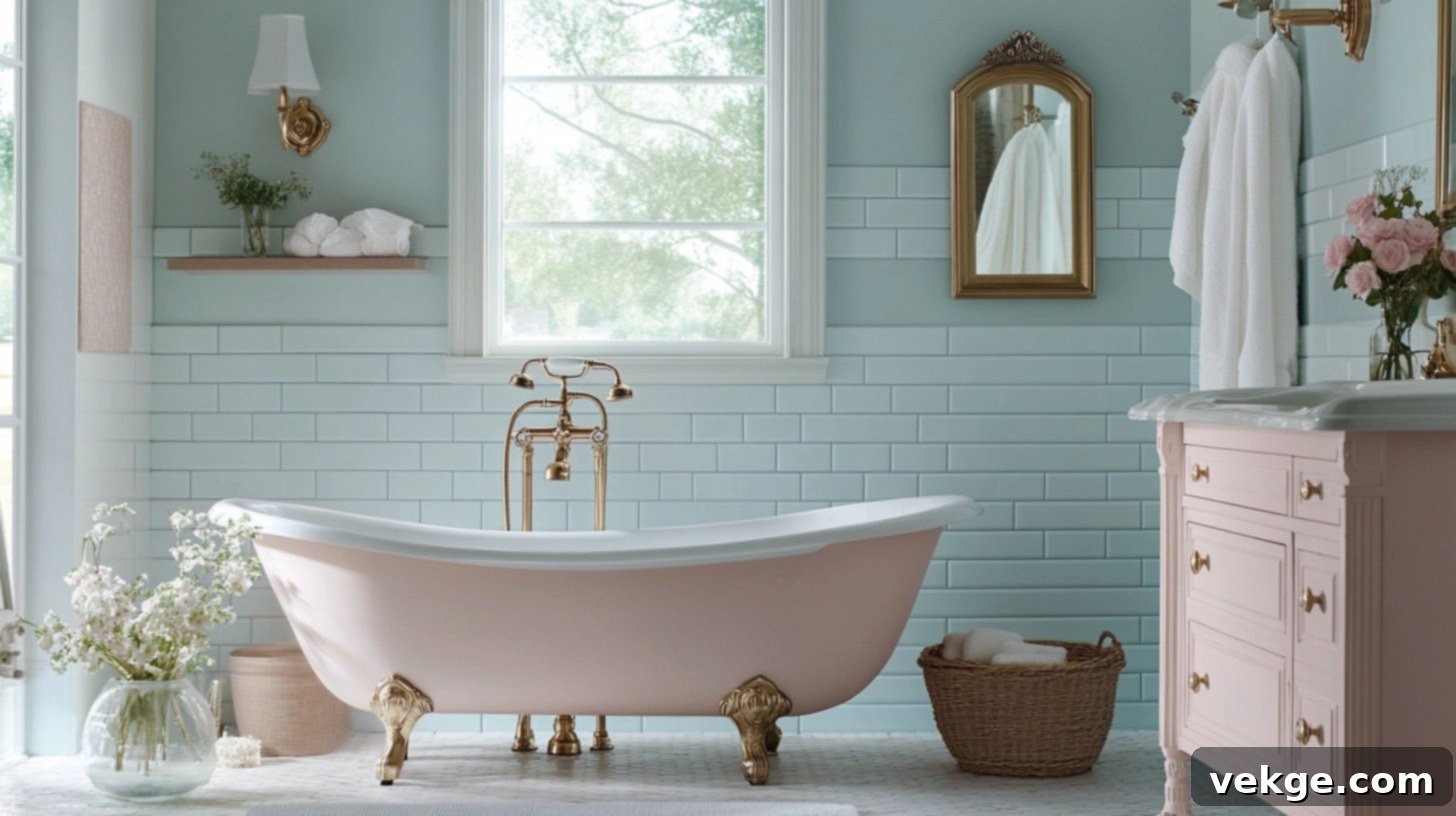
- Colors: Embraces soft, romantic hues such as dusty pinks, serene pastel blues, creamy ivory, and warm beige tones.
- Materials: Classic choices include glossy subway tiles, pristine white porcelain fixtures, and the timeless elegance of a clawfoot tub.
- Accessories: Adorn with ornate vintage mirrors, polished brass fixtures, and traditional wall sconces that cast a gentle glow.
- Inspiration: A design that evokes a sense of nostalgia and timeless elegance, creating a bathroom that feels both sophisticated and welcoming.
3. Modern Glamour
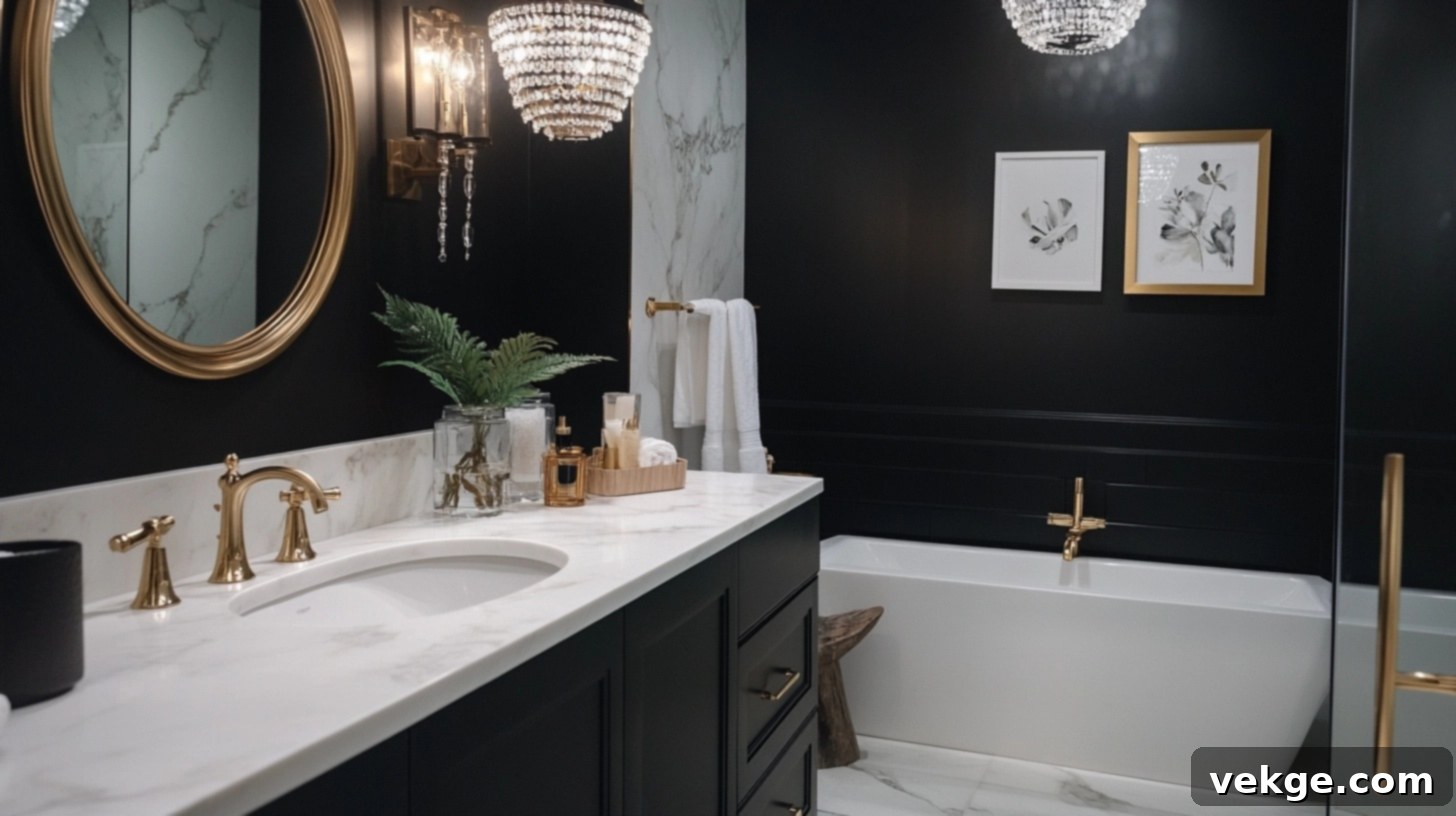
- Colors: A striking palette of crisp black and white, often punctuated with luxurious pops of gold or lustrous brass.
- Materials: Features opulent glossy marble, sleek glass elements, and reflective polished metals to enhance the upscale feel.
- Accessories: Illuminate with sparkling crystal lighting, select elegant gold or brass fixtures, and install a grand statement mirror to amplify light and drama.
- Inspiration: Perfect for adding a touch of unparalleled luxury and sophisticated elegance, transforming your bathroom into a high-end retreat.
4. Coastal Calm
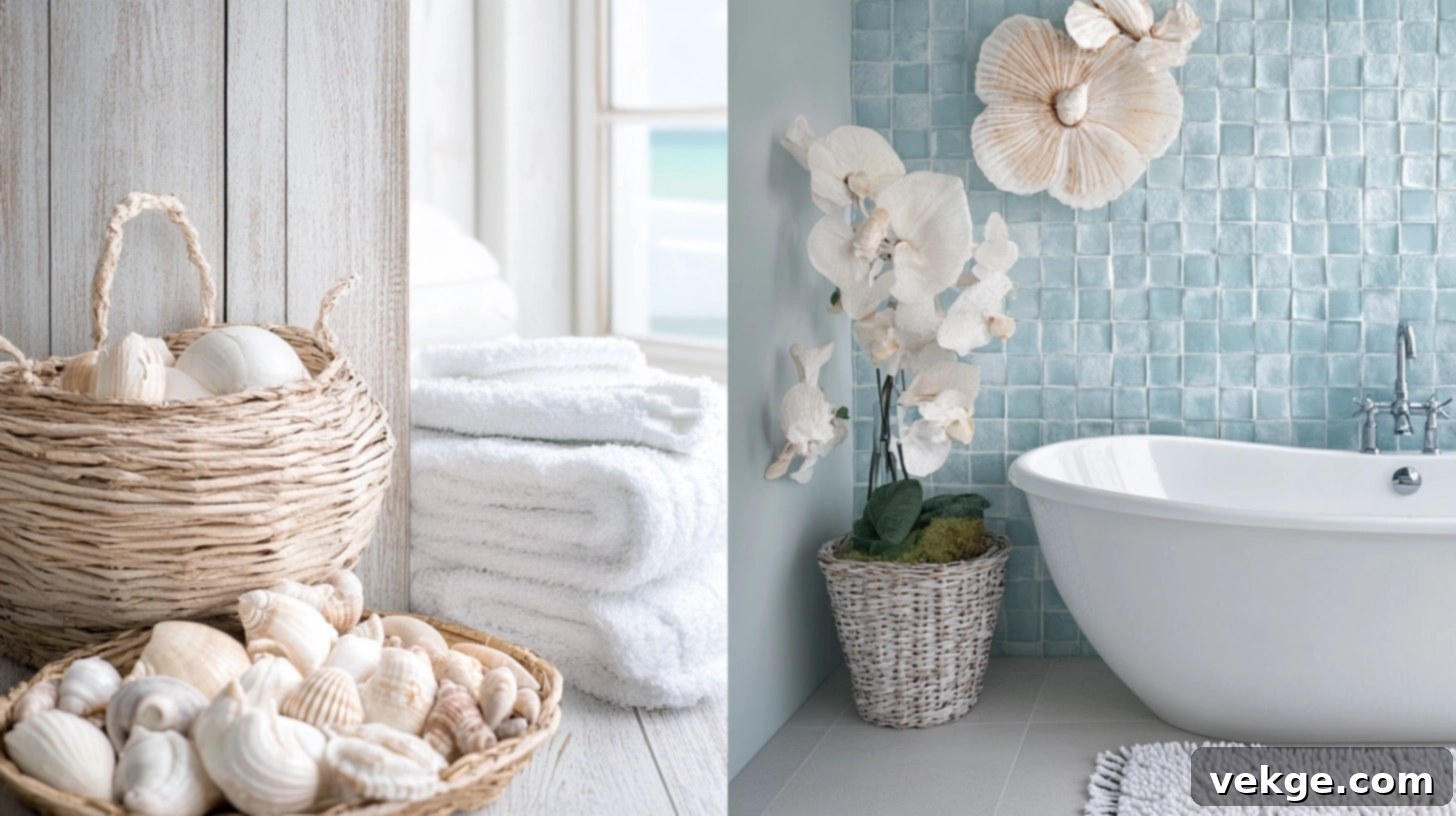
- Colors: A refreshing array of ocean-inspired blues, crisp whites, and soothing sandy beige tones.
- Materials: Incorporates natural elements like whitewashed wood, delicate sea glass accents, and airy light-colored tiles.
- Accessories: Decorate with charming nautical accents, practical yet stylish rattan baskets for storage, and organic touches like shells or artfully placed driftwood.
- Inspiration: Creates a breezy, sun-kissed, and tranquil environment, ideal for a beach-inspired bathroom or a home by the water.
5. Minimalist Serenity
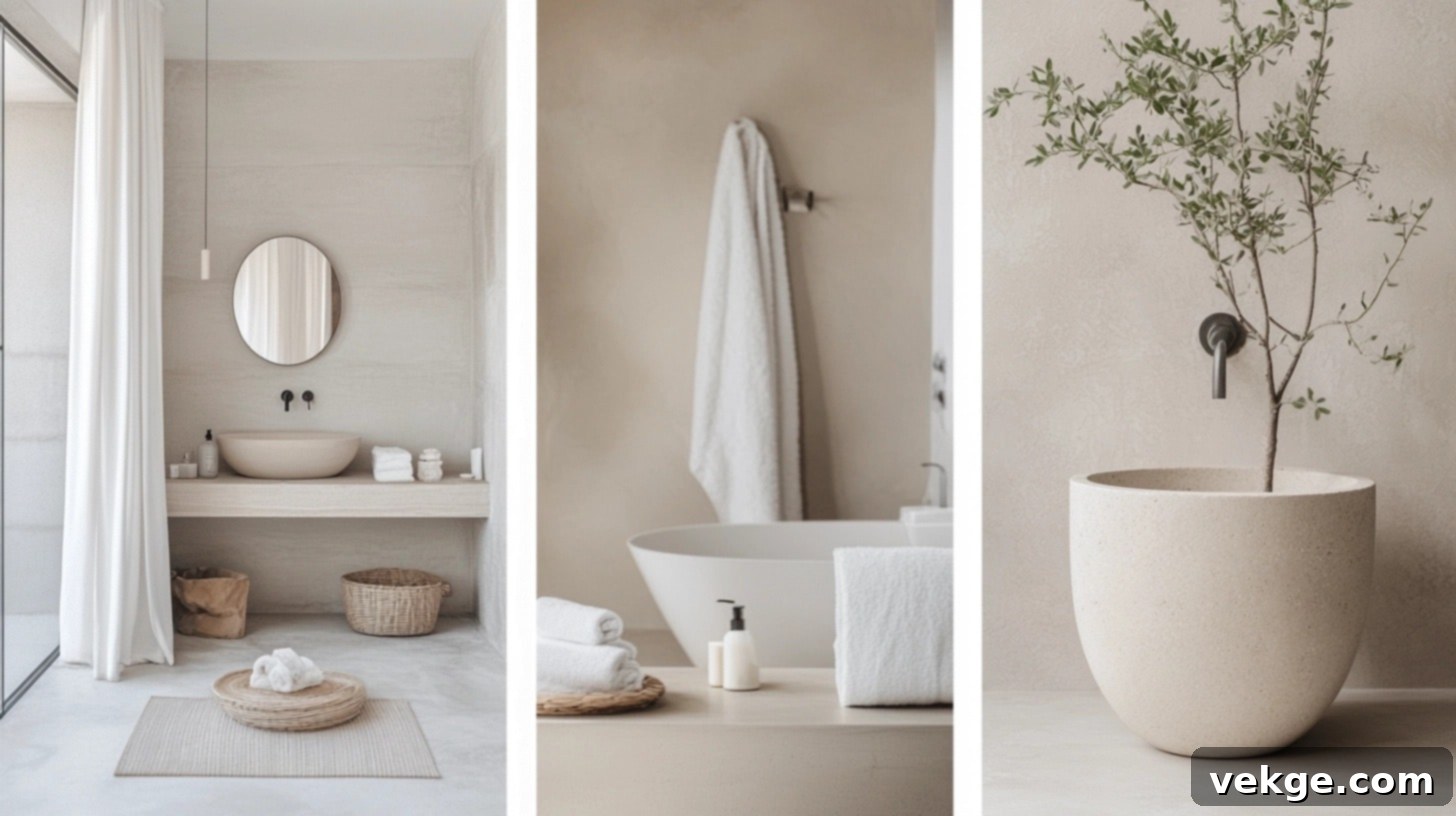
- Colors: A calming palette of soft whites, gentle light grays, and comforting warm beige tones.
- Materials: Employs sleek matte tiles, smooth polished concrete surfaces, and subtle light wood accents for warmth.
- Accessories: Choose simple, understated metal fixtures, install frameless mirrors for an uncluttered look, and add a few carefully chosen potted plants for a touch of vibrant greenery.
- Inspiration: Designed to create a supremely calming, elegant, and clutter-free atmosphere, promoting a sense of peace and order.
6. Scandinavian Spa
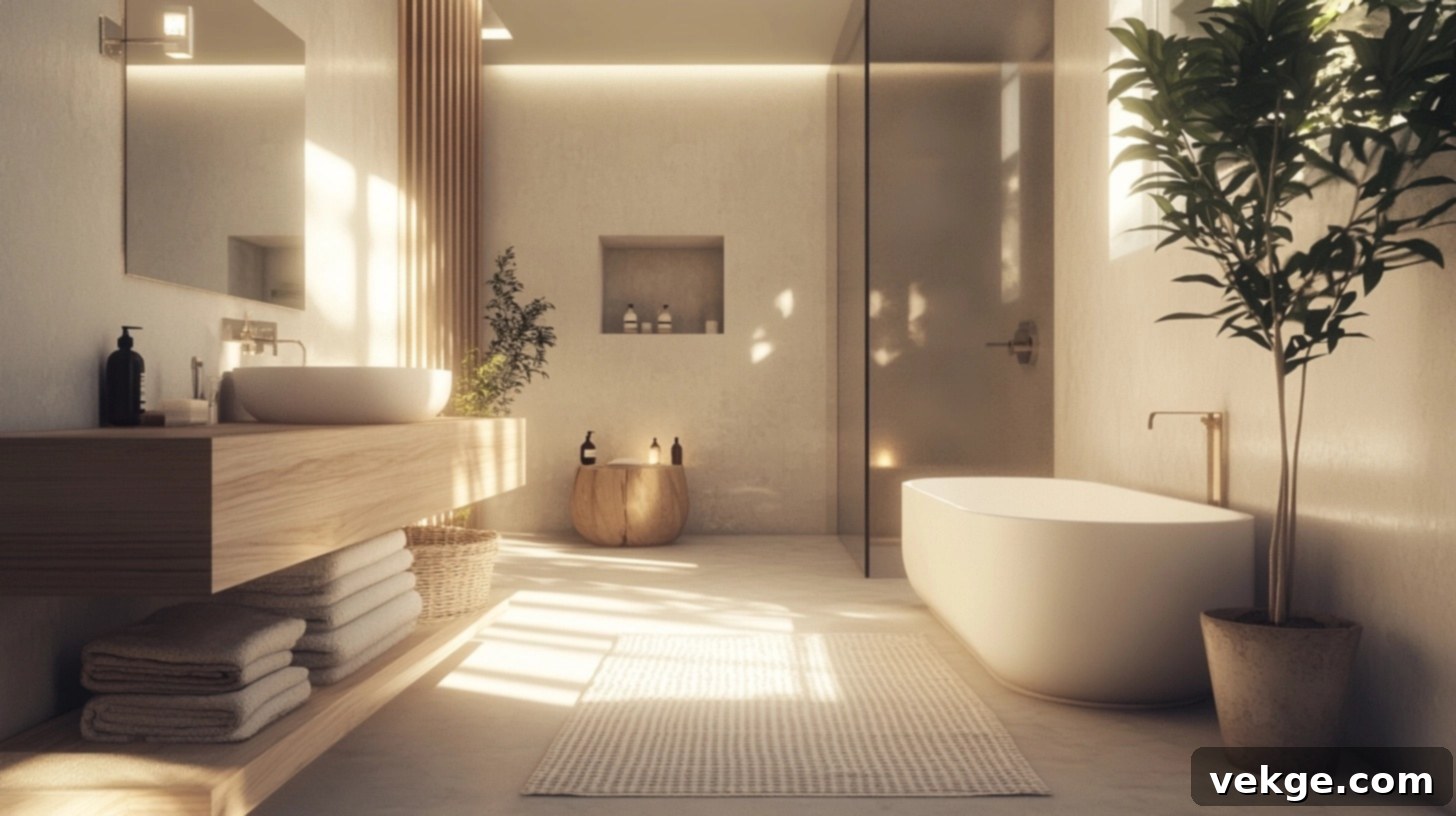
- Colors: Features a serene combination of neutral grays, pure whites, and inviting natural wood tones.
- Materials: Utilizes pale, light wood finishes, textured stone tiles, and crisp white ceramics for a clean, organic feel.
- Accessories: Opt for minimalist storage solutions, add plush bamboo bath mats, and integrate organic textures through linens and small decorative items.
- Inspiration: Crafts a peaceful, natural, and highly functional environment characterized by clean lines, natural light, and a sense of serene simplicity.
7. Rustic Retreat
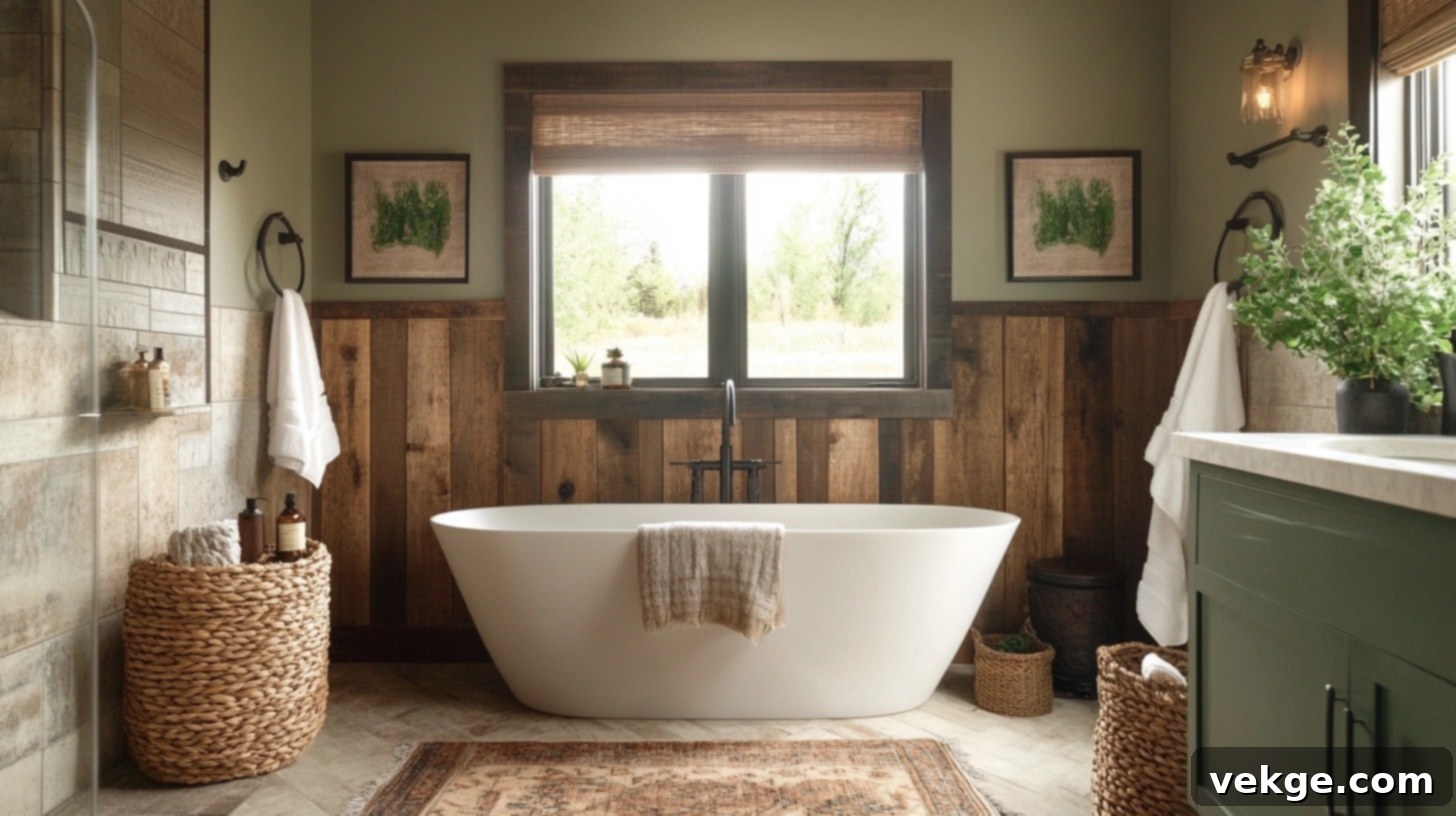
- Colors: A rich palette of earthy browns, deep forest greens, and warm, inviting natural wood tones.
- Materials: Showcases the beauty of reclaimed wood, rugged stone accents, and subtly distressed metals for an aged, authentic look.
- Accessories: Enhance the cozy feel with hand-woven baskets, install vintage-style faucets, and incorporate vibrant touches of greenery with plants.
- Inspiration: Ideal for creating a warm, cozy, and inviting ambiance, emphasizing natural textures and a connection to the outdoors.
Common Mistakes to Avoid When Creating Your Bathroom Mood Board
While a mood board is a powerful tool, certain missteps can hinder its effectiveness. Being aware of these common pitfalls will help you create a more accurate and useful design guide:
- Skipping Crucial Measurements: Rushing into design choices without precise room dimensions can lead to ill-fitting fixtures and awkward layouts. Always measure your space thoroughly first.
- Overloading with Patterns and Colors: Introducing too many competing patterns or an overly diverse color palette can result in a chaotic and visually jarring space. Aim for balance and harmony.
- Ignoring Material Suitability: Selecting materials purely for aesthetics without considering their resistance to water, humidity, and daily wear can lead to premature damage and costly replacements.
- Neglecting Storage Solutions: Forgetting to plan for adequate and integrated storage for toiletries, towels, and cleaning supplies can quickly turn a beautiful bathroom into a cluttered one.
- Mismatched Fixture Scale: Choosing fixtures (like a vanity or bathtub) that are either too large or too small for your bathroom’s proportions will make the space feel unbalanced or cramped.
- Inadequate Lighting Planning: Overlooking essential lighting for daily tasks (e.g., shaving, applying makeup) or for creating ambiance will result in a poorly lit and uncomfortable bathroom.
- Disregarding Your Budget: Not consistently checking if the items on your mood board align with your financial plan can lead to significant cost overruns and compromises down the line.
- Forgetting Functional Clearances: Failing to plan for comfortable spaces between fixtures (e.g., clearance around the toilet, swing space for cabinet doors) can make the bathroom awkward to use.
- Chasing Fleeting Trends: While keeping an eye on trends is fine, basing your entire design solely on them can result in a bathroom that feels dated quickly. Aim for timeless elements with trendy accents.
- Not Testing Colors in Context: Failing to view paint and material samples in your actual bathroom’s lighting conditions means colors might look entirely different once installed.
By actively avoiding these mistakes, your bathroom mood board will serve as an even more robust and reliable blueprint for your renovation project.
Strategic Budgeting and Cost-Saving Tips for Your Bathroom Renovation
A beautiful bathroom transformation doesn’t have to break the bank. Smart budgeting and strategic spending are key to achieving your dream space without financial strain.
Estimating Costs with Precision
Effective budgeting begins with a clear, detailed plan. I recommend breaking down your budget into distinct categories to track every expense:
- Labor: Allocate approximately 35% of your total budget to labor costs (plumbers, electricians, tilers, general contractors). This can vary based on your location and the complexity of the project.
- Fixtures: Dedicate about 20% to essential fixtures like your toilet, sink(s), bathtub/shower, and faucets.
- Tiles: Plan for 15% for all tiling – floors, shower walls, backsplashes.
- Plumbing: Set aside 10% for new pipes, rerouting, and associated plumbing work.
- Lighting: Allocate 10% for light fixtures, switches, and electrical work.
- Contingency Fund: Crucially, always set aside 10-15%, or even 20% for older homes, of your total budget for unexpected issues. This buffer is invaluable for unforeseen repairs, material shortages, or design changes.
This systematic breakdown helps you visualize where your money is going and empowers you to make informed decisions about where to splurge and where to save.
Where to Splurge vs. Where to Save Wisely
Not all items in your bathroom carry the same weight. Strategic allocation of funds can significantly impact both the functionality and longevity of your space.
- Splurge on Quality: Invest more money in items that are used daily, like high-quality faucets, durable shower systems, and efficient toilets. These components directly impact the bathroom’s functionality, user experience, and long-term performance. Similarly, tiles in high-moisture areas (like inside the shower) should be top-quality to prevent future problems and ensure longevity.
- Save on Aesthetics: You can often find stylish yet affordable options for items that are easily changeable or less critical to core functionality. Consider saving on items such as decorative mirrors (unless it’s a statement piece), cabinet hardware (there are many budget-friendly options that look luxurious), or accent lighting fixtures. Plain, good-quality white subway tiles for walls (outside the shower) can be very cost-effective and still offer a timeless look.
Sourcing Materials Affordably
Savvy shopping can lead to substantial savings without compromising design:
- Explore Clearance Sales: Regularly check clearance sections at tile stores, home improvement centers, and plumbing supply shops. You can often find high-quality, discontinued items or overstocked products at a fraction of their original price.
- Negotiate and Price Match: Don’t be afraid to ask local stores if they can match online prices or offer a discount, especially if you’re buying multiple items.
- Shop Smart for Basics: Purchase fundamental items like paint, basic hardware, and sealants from large home centers, which often have competitive pricing and frequent sales.
- Leverage Holiday Sales: Keep an eye out for major holiday sales events (e.g., Black Friday, Memorial Day, Labor Day) as these are prime opportunities to secure good deals on larger items like vanities, bathtubs, or even entire fixture sets.
- Consider DIY Where Possible: If you have the skills, doing minor tasks like painting, installing basic shelving, or assembling flat-pack furniture can save on labor costs.
By combining careful planning with astute shopping, you can create a beautiful and functional bathroom that perfectly fits your vision and your budget.
Wrapping It Up: Your Journey to a Dream Bathroom Starts Now
Creating a bathroom mood board is far more than just compiling pretty pictures; it’s a strategic, invaluable process that empowers you to visualize, plan, and execute your dream bathroom design with confidence. It’s the ultimate tool for turning abstract aspirations into a tangible, actionable plan, saving you precious time and money while ensuring your final space is everything you envisioned.
Let’s recap the essential takeaways: Begin by deeply understanding and defining your unique personal style. This foundation will guide every subsequent choice. Next, diligently gather inspiration and physical samples, using both digital platforms and local showrooms to curate a rich collection of ideas. Finally, meticulously plan your budget, identifying where to invest and where to save, while keeping common design pitfalls in mind.
Your mood board acts as your personal design compass, helping you catch potential problems early, streamline your shopping experience, and communicate your vision clearly to any professionals involved in your project. It ensures every element you select, from the smallest tile to the grandest fixture, harmoniously contributes to the overall aesthetic and functionality of your sanctuary.
So, what’s your next step on this exciting journey? Don’t delay! Grab your phone or open your favorite browser and start saving those inspiring bathroom photos. Head to your local hardware store and collect paint chips and tile samples that catch your eye. Begin measuring your space with a fresh perspective. Remember, even the smallest, most deliberate steps lead to the most magnificent results.
Your bathroom should be a reflection of your personality and a space that genuinely works for your lifestyle. A well-crafted mood board is your indispensable roadmap to achieving exactly that. I’d absolutely love to hear about your bathroom plans and design ideas. Share your vision in the comments below – let’s inspire each other to create truly amazing spaces!
